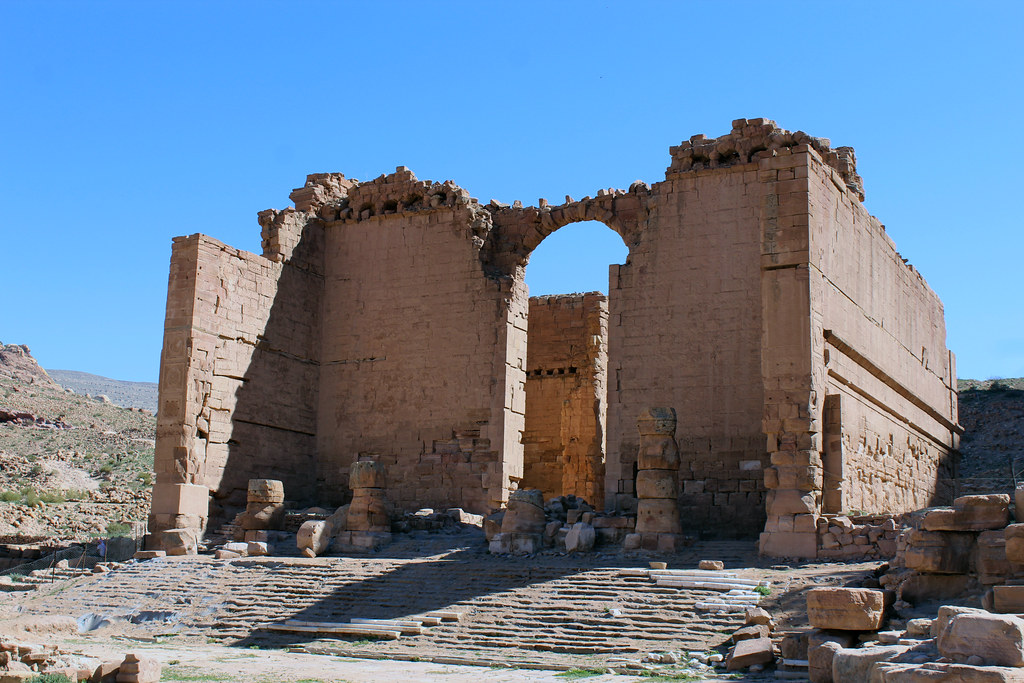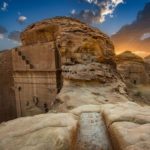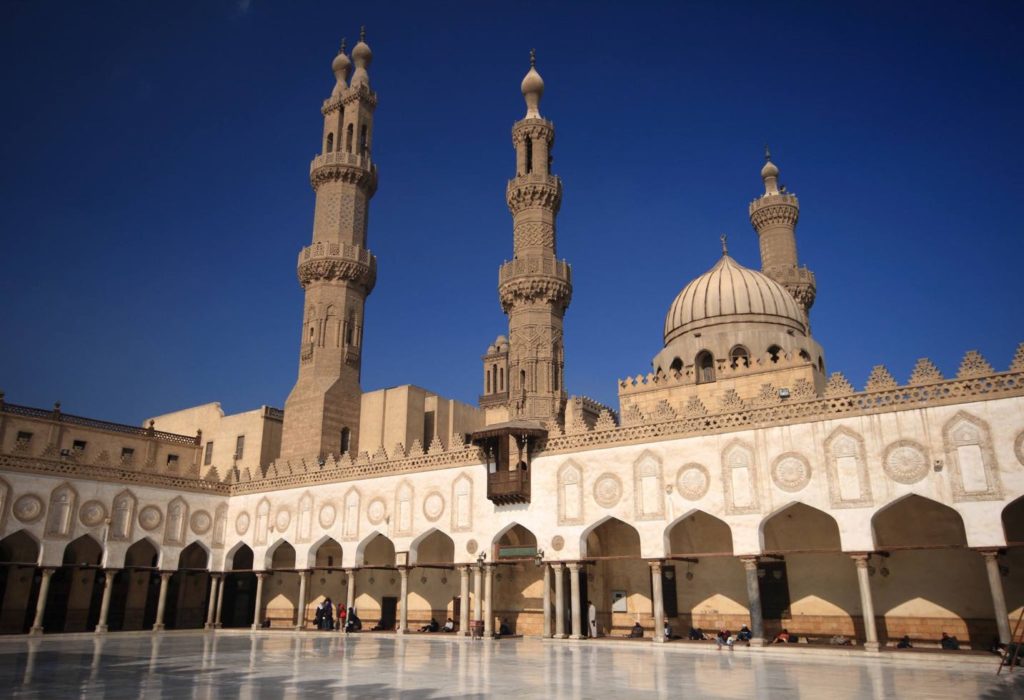
The qibla to which the Prophet of Islam turned towards is Petra, not Makka in the Hijaz. The proof of this is that all of the mosques built in the first century after the advent of Islam had the wall towards which the worshippers lined up pointing towards Petra (mosques in the beginning did not have a miḥrāb).
THE ‘AMR IBN AL-‘ĀS MOSQUE in Fusṭāṭ, built in 641 AD, was modernized in 673 AD during the reign of Mu‘āwiya ibn Abī Sufyān who added four minarets to it, one in each corner. The first plans of the mosque show that the miḥrāb was facing north. Al-Maqrīzī says that Amr ibn al-‘Ās used to pray eastward, not towards the southeast where Makka is located[1] If ‘Amr ibn al-‘Ās prayed eastward, it meant that he was praying towards Petra and not Makka.
The Al-Aqṣā Mosque. Construction for this began during the reign of ‘Abd al-Malik ibn Marwān in 709 AD, and it was completed during the reign of his son al-Walīd. After it was partly destroyed by earthquakes that struckJerusalem, it was restored by the Caliph al-Mahdī. The direction of the miḥrāb in this mosque is 169 degrees, which is the angle of Petra from Jerusalem.[2]
The Anjar Mosque near the Litani River in Lebanon, built in 714 AD by the Umayyad Caliph Al-Walīd ibn ‘Abd al-Malik. By the end of the Umayyad era and the beginning of the Abbasid era the mosque had fallen into disrepair and the building had sustained cracks. This mosque and the complex that contains it are directed towards Petra, not towards Makka [3].
1 – The Islam of al-Ṭufayl ibn ‘Amr: Ibn Hishām records in his Sīra (‘biography’ of the Prophet), that when al-Ṭufayl ibn ‘Amr became a Muslim, he said:
‘My wife then came to me, and I said: “Be off with you, for I have nothing to do with you, or you with me!” “Why?” she said, “my father and mother be your ransom!” I said, “Islam has divided us, and I follow the religion of Muḥammad (peace and blessings of Allah be upon him).” She replied: “Then my religion is your religion”. To which I said: “So then go to the ḥinā of Dhū ’l-Sharā and cleanse yourself from it”.
Ibn Hishām goes on to explain that
Dhū ’l-Sharā was an idol belonging to Daus and the ḥinā (also termed ḥimā) was the temenos which they had made sacred to him; in it there was a trickle of water from a rivulet from the mountain. She asked me urgently, “Have you any fear from him on my account?” ‘No”, I said, “I will go surety for that.” So she went and washed, and when she returned, I explained Islam to her, and she became a Muslim’”[4]
Dhū ’l-Sharā was one of the Nabatean idols in Petra and was not in Makka. This indicates that Islam began in Petra and not in what is present-day Makka.
2- Ibn Hishām also tells us in the Sīra that
“In the following Hajj season, twelve men from the Muslims of Yathrib came to Makka,, ten Khazraj and two from the Aws, who met with the Messenger of Allah at ‘Aqaba and pledged allegiance to him, a pledge known in Islamic history as the first or ‘minor’ pledge of allegiance in which they pledged not to associate anything with Allah, not to steal, not to commit fornication nor kill their offspring, not to slander their neighbours and not to disobey him in what was right.”
The word ‘aqaba in Arabic means a place or a rugged object difficult to reach. The Qur’ān says, But he would not attempt the uphill road (‘aqaba), and what will make you comprehend what the uphill road is?[5]
The ‘aqaba in present-day Makka is in a plain that has neither mountains nor any rugged terrain while Aqaba at the tip of the Gulf of Aqaba has mountains and a difficult terrain. The Anṣār must have gone from Petra to meet with Muḥammad in Aqaba that was near to Yathrib.
3- The Qur’an addresses the people of Makka and says to them: I swear by the fig and the olive, and mount Sinai, and this city made secure.[6] Now what do the people of Makka know about figs and olives? Rhetorical effect means addressing people with what they understand. This speech was for the people of Petra, especially since the Qur’ān mentions Ṭūr Sinīn, that is the Ṭūr or ‘Mount’ Sinai. Thus the address is to the people of Petra, which boasted gardens of figs and olives, and which are near to Mount Sinai.
Present-day Makka did not exist at the time of Muḥammad and the emergence of Islam
The conclusion from all this line is that present-day Makka did not exist at the time of Muḥammad and the emergence of Islam, while Petra was known and prosperous with its water and its orchards, and was the capital of the Nabataeans, speakers of the Nabataean language from which Arabic developed. Today, we do not possess any a trace from the pre-Islamic period by which archaeologists may deduce anything about the history of Makka before Islam, and thus everything said about it derives from the accounts of the storytellers, whose accounts are conflicting and contradictory and in which emotions played a prominent part. No one can today write anything reliable, reasonable and acceptable about the history of this holy city in the days of the ancient pre-Islamic era, since he does not have any archaeological inscriptions to help him.[7]
Someone may well ask why it was that the Ka‘ba was moved from Petra to present-day Makka. The answer lies in the fact that when ‘Abdullah ibn al-Zubayr rebelled against Yazīd ibn Mu‘āwiya and declared himself the caliph of the faithful in Petra, Yazīd sent against him a large army from the Levant. The army was unable to enter Petra because it was walled. So they besieged the city for 40 days, during news came to them that Yazīd had died. The army thereupon returned to the Levant in order to pledge allegiance to Mu‘āwiya ibn Yazīd. Since the distance between Petra and Damascus was short, and ‘Abdullah bin Zubayr was sure that the Levant army would return to lay siege to Petra again, he decided to move his people and the Black Stone to the present-day Makka, a distance of 1,385 kilometres from Damascus. This may have made the new caliph reluctant to send an army to Makka due to the distance involved. ‘Abdullah ibn al-Zubayr therefore demolished the Ka‘ba, took the Black Stone and migrated to present-day Makka.[8]

Suggested Reading
The present-day Makka had no walls, but when Yazīd ibn Mu‘āwiya’s army came it besieged ‘Makka’ for forty days. Why lay siege to an unwalled city that he could enter easily with his large army? The reason is that ‘Makka’ was Petra, a place surrounded by walls on all sides and having only two points of entry in the middle of the mountains, one at the top of the city and one at the bottom.
It is clear that the entire history of Islam, according to the books of the heritage, lacks foundation. Even the Quraysh tribe, which they claim to be the noblest of the Arab tribes, and that Muḥammad was from one of its noblest branches – the Banū Hāshim – does not exist in non-Islamic history books. The Iraqi historian Jawād Alī concludes the following:
We have still not come across name ‘Quraysh the people of Makka’ in any pre-Islamic text. Nor have we found this, or any name similar to it, in the books of the Greeks, the Romans or the ancient Syrians who lived before Islam. We cannot talk of a pre-Islamic time in which we can say that we have found the name of Quraysh, or that such a name was known at that period.[9]
[1] Al-Maqrīzī, as cited in Dan Gibson, Quranic Geography, p.255. View this book in the Almuslih Library here.
[2] Dan Gibson, p.260.
[3] Dan Gibson, p.263.
[4] Ibn Hishām السيرة النبوية tr. Alfred Guillaume, The Life of Muhammad, Oxford University Press, 1998, p.176. Dan Gibson (Four Ka’bas, April 2018) also includes a note from John Healy (The Religion of the Nabataeans, Brill, 2001, p.87) that the name Dhū ’l-Sharā was not a name but rather a title, meaning ‘the Lord of the Sharā [mountain range]’ and that the divinity’s actual name was probably Hubal. His temple abutted the Ka’ba at Petra, lending a new perspective to the passage in Hishām ibn al-Kalbī’s Kitāb al-Aṣnām (‘Book of Idols’) that: ‘the Quraysh had also several idols in and around the Ka’ba and the greatest of these was Hubal … it stood inside the Ka’ba’. (Ed.)
[5] The sense of the passage is contained in the following verses: But he would not attempt the uphill road, and what will make you comprehend what the uphill road is? (It is) the setting free of a slave, or the giving of food in a day of hunger to an orphan near of kin, or to the poor man lying in the dust. [Qur’ān XC (al-Balad), 11-16]. (Ed.)
[6] Qur’ān XCV (al-Tīn) 1.3.
[7] Jawād ‘Alī, المفصل في تاريخ العرب قبل الإسلام Vol. 2, p.404.
[8] Dan Gibson, Op. cit., pp.296-298.
[9] Jawād ‘Alī, Op. cit., p.406.
Main image: The ‘Qaṣr al-Bint‘, the Ka‘ba of Dhū ’l-Sharā at Petra.

